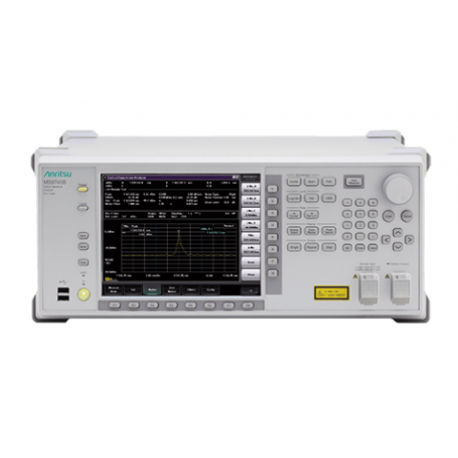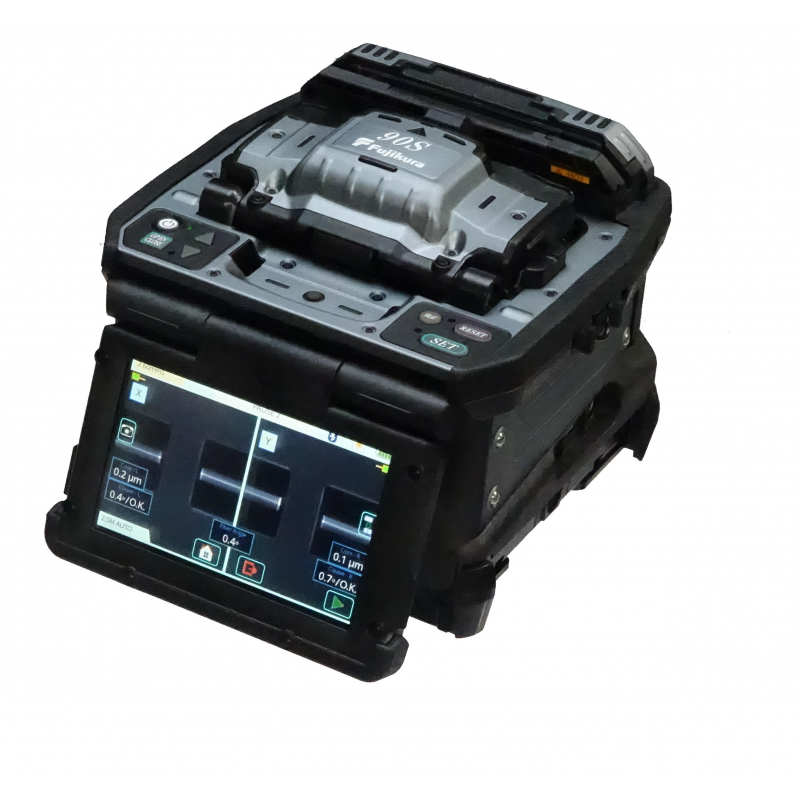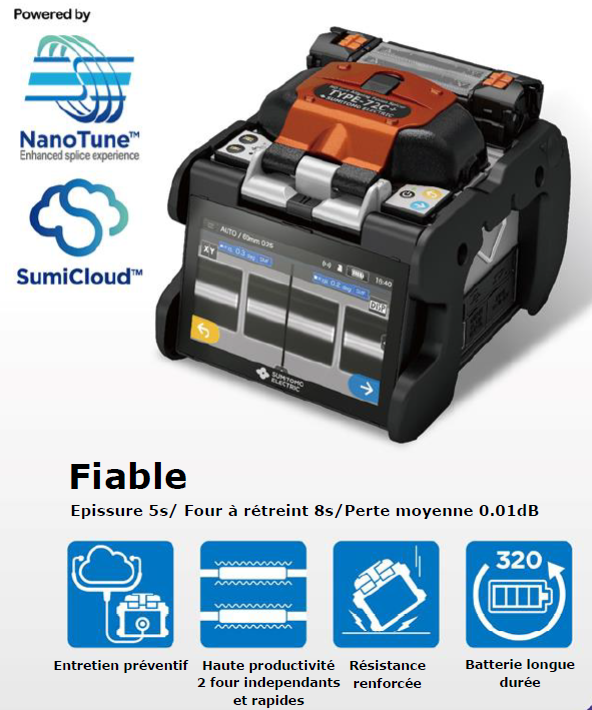Aucun produit
-
Reduction sur aiguille jaune
5% de réduction Aiguillage5 -
Soudeuse Optique
4% de réduction Soudeuse4
 Agrandir l'image
Agrandir l'image
ANRITSU MS9740B Analyseur de spectre optique 600 - 1750 nm
MS9740B
Reconditionné
Reduces Measurement Time and Improves Production Efficiency
● Wavelength sweeping time <0.35 s
● Dedicated applications for evaluating active optical devices
● Excellent cost performance
● Dynamic range performance ≤58 dB (0.4 nm from peak wavelength)
● 30 pm minimum resolution
Matériel reconditinné garanti 6 mois PMO
-
L'OSA Anritsu MS9740B se caractérise par une large plage dynamique, une haute résolution et une vitesse de balayage rapide sur une plage de longueurs d'onde allant de 600 nm à 1750 nm. Il dispose d'une entrée de fibre multimode et est idéal pour la fabrication et l'évaluation de modules VCSEL de la bande 850 nm.
En plus de conserver les mêmes fonctions et performances que son prédécesseur, le MS9740B réduit les temps de traitement des mesures jusqu'à la moitié (Rx bandwidth setting: 1 kHz or 200 Hz) tout en surmontant les problèmes de sensibilité de mesure réduite causés par l'augmentation de la vitesse de traitement.
De plus, il conserve les écrans de menu de mesure des dispositifs actifs optiques (LD-Module, DF-LD, FP-LD, LED, PMD, WDM, Opt Amp et filtre WDM) pour l'évaluation des dispositifs. Il prend en charge des mesures simultanées de paramètres clés d'évaluation, tels que la longueur d'onde centrale optique, le niveau, le rapport signal sur bruit optique (OSNR), la largeur de spectre, etc., et affiche ces résultats sur un seul écran.
Principales spécifications:
Wavelength measurement range 600 nm to 1750 nm Applicable optical fiber SM fiber (ITU-T G.652), 50μm/125μm GI fiber Optical connector User replaceable: FC, SC, ST, DIN Wavelength accuracy*1 ±20 pm (1520 nm to 1620 nm, Resolution: 0.03 nm to 0.2 nm)*2
±100 pm (1520 nm to 1620 nm, Resolution: 0.5 nm, 1.0 nm)*2
±300 pm (600 nm to 1520 nm)*3
±200 pm (1520 nm to 1570 nm)*3
±300 pm (1570 nm to 1750 nm)*3Setting resolution 0.03, 0.05, 0.07, 0.1, 0.2, 0.5, 1.0 nm (RBW 3 dB transparent bandwidth) Maximum input power +23 dBm (Optical ATT: On) Dynamic range*1 High dynamic range: 70 dB (±1 nm from peak wavelength), 60 dB (±0.4 nm from peak wavelength), 42 dB (±0.2 nm from peak wavelength)
Normal dynamic range: 62 dB (±1 nm from peak wavelength), 58 dB (±0.4 nm from peak wavelength), 42 dB (±0.2 nm from peak wavelength)
[Wavelength: 1550 nm, Resolution: 0.05 nm, Optical Att: Off, 20° to 30°C]Sweep*1 Sweep time: ≤0.2 s (span: 5 nm, Resolution: 0.1 nm), ≤0.3 s (span: 500 nm)
[VBW: 10 kHz, Normal dynamic range, center 1550 nm (span: 5 nm), 1200 nm (span: 500 nm), sweep start to stop, no optical input, sampling point: ≤501]
Sweep time: 0.35 s / 30 nm (typ.)
[VBW: 1 kHz- Fast, dynamic range, center 1550 nm, Resolution: 0.1 nm, sweep start to stop, optical input -10 dBm, sampling point: 1001]
Sweep time: 1,65 s / 30 nm (typ.)
[VBW: 200 Hz-Fast, dynamic range, center 1550 nm, Resolution: 0.1 nm, sweep start to stop, optical input -10 dBm, sampling point: 1001]SMSR Reproducibility (with MS9740B-020) ±1.4 dB (MS9740B), ±1.8 dB (with MS9740B-009 installed)
Using SM fiber and DFB-LD with 1550 nm wavelength at 10 dBm peak power input, with 45 dB max SMSR and no change in polarization conditions
Pulse conditions: 5 kHz min repetition frequency and 1% min Duty
Pulse Mode enabled, 1 kHz VBW, 0.1 nm Setting Resolution, 10 nm max span, 501 sampling points, at 23°C ±5°CDimensions and Mass 426 (W) × 177 (H) × 350 (D) mm (excluding projections) ≤15.0 kg (without option) *1: Warm-up the instrument for at least 2 hours before measurement by performing repeated sweeping at span ≥ 100 nm, VBW ≥ 10 kHz. Perform waveform calibration after auto-optical alignment (WI Cal) and keep the instrument at the same temperature unless stated otherwise. Use either SM fiber (ITU-T G.652) or GI fiber (50μm/125μm) with a return loss of >40 dB, or GI fiber (62.5μm/125μm) with a return loss of >38 dB
*2: Built-in MS9740B-002, after Wl cal (ref) wavelength calibration execution, at stable room temperature
*3: After Wl cal (Ext) wavelength calibration execution by external light source, such as Single Longitudinal mode laser (DFB-LD), using SM fiberExemples d'application de mesures:
WDM Application The 42 dB dynamic range at 0.2 nm from the peak wavelength supports accurate WDM signal measurement at 100 and 50-GHz intervals. Up to 300 channels can be evaluated and data required for WDM signal analysis, such as center wavelength, level, SNR, etc., are displayed on one screen. Specification of the noise location, which is required at OSNR analysis, can be selected using two estimation methods; 2-point interpolation, and noise fitting interpolation of a specified noise area. The 2-point interpolation method auto-analyzes the Dip point between each channel, but the distance from the center wavelength can be specified.
LD Module Test Analysis This application measures test items such as center wavelength, optical level, OSNR, etc., required for LD module tests, and displays the results on one screen. The center wavelength, optical level, OSNR (per nm), side mode suppression ratio (SMSR) and 20 dB down spectrum width of LD modules can be measured. The center wavelength and spectrum half-width (FWHM) of FP-LDs or VCSELs are measured using the RMS method. Both SM and MM fibers are supported by one unit, helping cut equipment costs.
Supports Optical Pulse Measurement Function for Thermal Countermeasures at LD Chip Production Testing
With production of high-bit-rate LDs supporting recent deployment of high-speed networks, thermal countermeasures at LD chip production have become an issue in both communications and non-communications fields. There is increasing demand for spectrum measurement using pulsed optical input as a solution to this issue. Generally, accurate spectrum measurement of optical pulse signals uses synchronization with an input trigger signal. However, since the sweep speed is relatively slow compared to CW measurement that does not require synchronization, this measurement using a trigger signal is especially problematic due to the importance of tact time at manufacturing and inspection. Using the MS9740B with installed Option 020 (MS9740B-020) in the optical pulse measurement mode supports measurement of the LD pulsed optical spectrum without requiring input of a trigger signal in a similar time to that required for CW optical spectrum measurement under asynchronous conditions. Additionally, the key SMSR parameter evaluation achieves a high measurement reproducibility of ±1.4 dB
WDM Filter Measurement Application
Fast evaluation of optical devices requires short inspection times using high-efficiency measuring equipment. The MS9740B adds a new WDM Filter analysis function supporting group display for optical bandpass filters, such as WSS and WDM Filter devices.
Transmittance Evaluation
The WDM Filter analysis function supports efficient evaluation of optical bandpass filter transmittance characteristics




